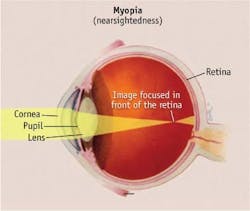Frontiers in Optics 2012: Contact lenses could cure myopia
Washington, DC--Biomedical scientist David Troilo and colleagues at the State University of New York (SUNY) College of Optometry (New York, NY) are developing a potential cure for myopia—nearsightedness—by using specialty contact lenses that coax the eye to grow in a way that can correct nearsighted vision while reducing myopia progression. Troilo will describe his findings at the Optical Society's Annual Meeting, Frontiers in Optics (FiO) 2012 (www.frontiersinoptics.org), taking place October 14-18 in Rochester, NY.
Nearsightedness, or myopia, affects more than 40% of people in the U.S. and up to 90% of children in some parts of Asia. The problem begins in childhood and often progresses with age. Standard prescription lenses can correct the defocus but do not cure nearsightedness, and do not slow progression rates as children grow. Myopia develops when the eye is too long, making it difficult to focus light from distant objects on the retina. Glasses or contact lenses that correct the defocus on the main visual axis can create a slight degree of farsightedness in the peripheral retina, Troilo says. The peripheral farsightedness may worsen myopia because as children grow, the eye grows to move the retina to where the light is focused, naturally lengthening the eye even further.
Troilo has shown that specially designed contact lenses that alter how light is focused in the peripheral retina can induce changes in growth that help reshape the eye in the desired way. The experimental lenses use different focal powers within a single lens: either alternating focal powers across the lens, or confined to the outer edge. Experiments with the new lenses found that they changed eye growth and refractive state, or focus, in a predictable way. The lenses successfully reduced the elongation of the eye that causes myopia progression.
The work will be presented at FiO on Wednesday, October 17 at 8 a.m. EDT at the Rochester Riverside Convention Center, presentation FW1C.1 "Optical Approaches for Controlling Myopia Progression: Evidence from Experimental Models."
Frontiers in Optics (FiO) 2012 (www.frontiersinoptics.org) is the Optical Society's (OSA) 96th Annual Meeting and is being held together with Laser Science XXVIII, the annual meeting of the American Physical Society (APS) Division of Laser Science (DLS). The organizers say that the two meetings unite the OSA and APS communities for five days of quality, cutting-edge presentations, fascinating invited speakers and a variety of special events spanning a broad range of topics in optics and photonics--the science of light--across the disciplines of physics, biology and chemistry. FiO 2012 will also offer a number of Short Courses and an exhibit floor featuring leading optics companies.
SOURCE: The Optical Society; www.osa.org/en-us/about_osa/newsroom/newsreleases/2012/specialty_contact_lenses_may_one_day_help_halt_the/

Gail Overton | Senior Editor (2004-2020)
Gail has more than 30 years of engineering, marketing, product management, and editorial experience in the photonics and optical communications industry. Before joining the staff at Laser Focus World in 2004, she held many product management and product marketing roles in the fiber-optics industry, most notably at Hughes (El Segundo, CA), GTE Labs (Waltham, MA), Corning (Corning, NY), Photon Kinetics (Beaverton, OR), and Newport Corporation (Irvine, CA). During her marketing career, Gail published articles in WDM Solutions and Sensors magazine and traveled internationally to conduct product and sales training. Gail received her BS degree in physics, with an emphasis in optics, from San Diego State University in San Diego, CA in May 1986.
